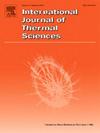Analytical solution of 3-D temperature field for the tunnels in seasonal cold regions using boundary separation method
IF 4.9
2区 工程技术
Q1 ENGINEERING, MECHANICAL
International Journal of Thermal Sciences
Pub Date : 2025-07-19
DOI:10.1016/j.ijthermalsci.2025.110149
引用次数: 0
Abstract
The incidents where the stability of surrounding rock is affected due to the imperfection of insulation layers in tunnels in cold regions occur frequently. The majority of the reasons might be that the distribution characteristics of the freezing radius of the surrounding rock were not accurately captured. Therefore, based on superposition principle and boundary separation methods, an analytical solution of the 3-D temperature field considering the influences of the axial heat transfer and temperature gradient for the tunnel surrounding rock was put forward in this paper. The correctness of the analytical solution was verified by the numerical results of finite element. Meanwhile, the following results were revealed. (1) The action of the axial heat transfer imposed by the annual average temperature cannot be ignored when calculating the freezing radius of the surrounding rock, especially in areas near tunnel entrance or exit. (2) The relationship of the freezing radius to z∗ is a nonlinear relation composed of multiple negative power exponential functions. (3) The results of variance analysis show that among all factors, the exposure time (t∗) has the greatest influence on the temperature at a depth of 7 m and a radius of 5 m for the tunnel surrounding rock. (4) The thermal conductivity coefficient (k), specific heat capacity (c), density (ρ) and annual average temperature (T2) all show a high degree of influence, in which the influence degrees of the two factors ρ and T2 on temperature are approximately the same. In addition, the temperature gradient (Gd) has a significant impact on the temperature of the surrounding rock and the maximum average growth rate of temperature in the surrounding rock is 54 times that when Gd is not considered. Research results are expected to provide opinions for the design of insulation layer for the tunnel surrounding rock.
季节寒区隧道三维温度场的边界分离解析解
寒冷地区隧道因保温层不完善而影响围岩稳定性的事故时有发生。其主要原因可能是围岩冻结半径的分布特征没有得到准确的捕捉。因此,本文基于叠加原理和边界分离方法,提出了考虑轴向传热和温度梯度影响的隧道围岩三维温度场解析解。有限元数值结果验证了解析解的正确性。同时,揭示了以下结果。(1)在计算围岩冻结半径时,特别是在隧洞出入口附近区域,年平均温度对轴向传热的作用不可忽视。(2)冻结半径与z *的关系是由多个负幂指数函数组成的非线性关系。(3)方差分析结果表明,在各因素中,暴露时间(t∗)对隧道围岩7 m深度和5 m半径处的温度影响最大。(4)导热系数(k)、比热容(c)、密度(ρ)和年平均温度(T2)均表现出较高的影响程度,其中ρ和T2对温度的影响程度大致相同。此外,温度梯度(Gd)对围岩温度有显著影响,围岩温度的最大平均增长率是不考虑Gd时的54倍。研究结果有望为隧道围岩保温层的设计提供参考。
本文章由计算机程序翻译,如有差异,请以英文原文为准。
求助全文
约1分钟内获得全文
求助全文
来源期刊

International Journal of Thermal Sciences
工程技术-工程:机械
CiteScore
8.10
自引率
11.10%
发文量
531
审稿时长
55 days
期刊介绍:
The International Journal of Thermal Sciences is a journal devoted to the publication of fundamental studies on the physics of transfer processes in general, with an emphasis on thermal aspects and also applied research on various processes, energy systems and the environment. Articles are published in English and French, and are subject to peer review.
The fundamental subjects considered within the scope of the journal are:
* Heat and relevant mass transfer at all scales (nano, micro and macro) and in all types of material (heterogeneous, composites, biological,...) and fluid flow
* Forced, natural or mixed convection in reactive or non-reactive media
* Single or multi–phase fluid flow with or without phase change
* Near–and far–field radiative heat transfer
* Combined modes of heat transfer in complex systems (for example, plasmas, biological, geological,...)
* Multiscale modelling
The applied research topics include:
* Heat exchangers, heat pipes, cooling processes
* Transport phenomena taking place in industrial processes (chemical, food and agricultural, metallurgical, space and aeronautical, automobile industries)
* Nano–and micro–technology for energy, space, biosystems and devices
* Heat transport analysis in advanced systems
* Impact of energy–related processes on environment, and emerging energy systems
The study of thermophysical properties of materials and fluids, thermal measurement techniques, inverse methods, and the developments of experimental methods are within the scope of the International Journal of Thermal Sciences which also covers the modelling, and numerical methods applied to thermal transfer.
 求助内容:
求助内容: 应助结果提醒方式:
应助结果提醒方式:


